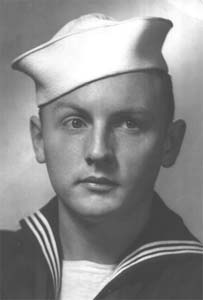Loren Williams in the Navy
Sparked by a request from Lee Williams for some Military History from our family.
|
I finished training early in 1947 and was assigned to the Aviation Electronics Shop on the USS Antietam, CV-36. The Antietam was an Essex Class carrier, with a flight deck about 880 feet long. (The Yorktown, in Charleston, was built to the same specs.) Shortly after I joined her, the Antietam set off on a 10 month good will cruise of the Pacific. From San Francisco we went to Hawaii, Sydney, Truk, Guam, Saipan, Manila, Tokyo Bay, Tsingtao, Guam, Hawaii and back to San Francisco. We cruised up and down the California coast during 1948 and early in 1949, we began to put the ship in "mothballs" since the defense budget was tight. I was assigned to the Alameda Naval Air Station, across the bay from San Francisco, for the last few months of my enlistment and was discharged as an Aviation Electronics Technician First Class from Treasure Island. As I reflect on that experience, four events most frequently come to mind. The first took place in Tsingtao, China in late September or early October 1947. At that time, Tsingtao was surrounded on land by Chinese Communist forces. The Nationalists, under Chiang Kai Shek still controlled the city and an airfield. While ashore one evening, a shipmate and I engaged two rickshaws for a trip to a nightclub (Tsingtao was a German enclave in the early 1900's and there was influx of White Russians during and after the Russian revolution, so there was a noticeable international community there) in the international section near the outskirts of the city. We told the rickshaw boys they could take us back to the pier in a couple of hours, if they were still there when we were ready to leave. They were and we got in and headed back to the pier. After a while we realized that we were not returning the same way we came out - and at about that time the rickshaws stopped and we were suddenly surrounded by 5 or 6 rickshaw boys whose English was sufficient to let us know they wanted all our money. We were unhappy. As things were getting more tense we happened to notice a Chinese policeman and a Shore Partrolman walk under a streetlight several block away. We quickly decided we would, on the count of three, break through the ring and run, hollering "Shore Patrol" all the way. We did just that and our adventure was over. The second event also took place in Tsingtao. We were anchored about a half mile off shore and we had contracted with a Chinese boat to receive our garbage. The boat would come alongside and we would dump garbage cans into the boat. One one occasion I saw a member of the Chinese crew discover a half eaten hot dog in the garbage and eat it immediately as if he had found a delicacy and as if he were starving - and he probably was. This was my first awareness of the distinction between the "haves" and "have nots" of our world. The third event took place off the California coast. We had an air group on board and they were practicing take offs and landings. All propellers; no jets. On landing it was critical for the plane's tail hook to catch one of the dozen or so cables stretched across the deck. If the tail hook didn't engage, hydraulically actuated barrier cables were immediately raised about 6 ft. high to protect planes parked forward of the landing area. A barrier cable crash always made a mess. At a minimum the aircraft's propeller was torn up. Our electronics shop was just underneath one of the barrier cables, separated by 1/4 inch thick steel plate and 4 inches of oak planking. On the day in question, I was in the shop with a couple of other guys, we heard the barrier crash (not new, we had heard these before) and then there were little pieces of metal flying around the shop. By the time we took cover under our work benches, all of the excitement was over. I still have one of the pieces of propeller that was bouncing off our walls. Fortunately, no one was injured. The last story also relates to flight operations. For launching aircraft, we tried to get a 50 knot* wind from forward to aft. To do this, the ship would be turned into whatever wind there was and the engines cranked up to give a speed of 33 knots (max.) - less if we had a strong wind. From time to time my duties took me to the flight deck when we were launching aircraft and I calibrated myself as a wind speed measuring device. I learned that if I leaned into a 50 knot wind it would almost support me and keep me from falling down. So when I come back from a morning walk at Seven Devils on a windy day, I can tell Sarah with some confidence that he wind was more or less than 50 knots! When I was discharged in 1949, I joined the Naval Reserves, was called up for the Korean War in Sept. 1951, spent an uneventful 15 months as an instructor at the Aviation Electronics School at NAS Memphis and was discharged again in December 1952. -- Loren Williams |
